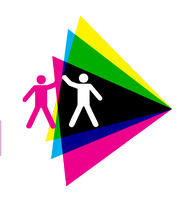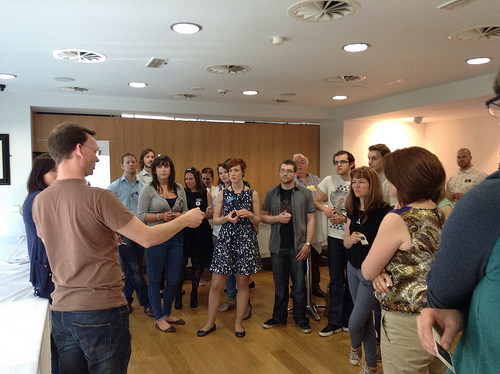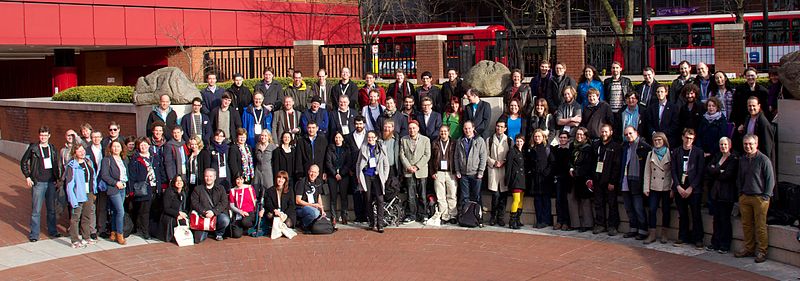I'm just back from giving at a lightning talk for the Cultural Connections strand of the Digital.Humanities@Oxford Summer School 2013, and since the projector wasn't working to show my examples during my talk I thought I'd share my notes (below) and some quick highlights from the other presentations.
Mark Doffman said that it's important that academic work challenges and provokes, but make sure you get headlines for the right reasons, but not e.g. on how much the project costs. He concluded that impact is about provocation, not just getting people to say your work is wonderful.
Gurinder Punn of the university's Isis Innovation made the point that intellectual property and expertise can be transferred into businesses by consulting through your department or personally. (And it's not just for senior academics – one of the training sessions offered to PhD students at the Open University is 'commercialising your research').
Giles Bergel @ChapBookPro spoke on the Broadside Ballads Online (blog), explaining that folksong scholarship is often outside academia – there's a lot of vernacular scholarship and all sorts of domain specialists including musicians. They've considered crowdsourcing but want to be in a position to take the contributions as seriously as any print accession. They also have an image-match demonstrator from Oxford's Visual Geometry Group which can be used to find similar images on different ballad sheets.
Christian von Goldbeck-Stier offered some reflections on working with conductors as part of his research on Wagner. And perfectly for a summer's day:
Christian quotes Wilde on beauty: "one of the great facts of the world, like sunlight, or springtime…" http://t.co/8qGE9tLdBZ #dhoxss
— Pip Willcox (@pipwillcox) July 11, 2013
My talk notes: 'From broadcast to collaboration: the challenges of public engagement in museums'
I’m interested in academic engagement from two sides – for the past decade or so I was a museum technologist; now I’m a PhD student in the Department of History at the Open University, where I’m investigating the issues around academic and ‘amateur’ historians and scholarly crowdsourcing.
As I’ve moved into academia, I’ve discovered there’s often a disconnect between academia and museum practice (to take an example I know well), and that their different ways of working can make connecting difficult, even before they try to actually collaborate. But it’s worth it because the reward is more relevant, cutting-edge research that directly benefits practitioners in the relevant fields and has greater potential impact.
I tend to focus on engagement through participation and crowdsourcing, but engagement can be as simple as blogging about your work in accessible terms: sharing the questions that drive your research, how you’ve come to some answers, and what that means for the world at large; or writing answers to common questions from the public alongside journal articles.
Plan it
For a long time, museums worked with two publics: visitors and volunteers. They’d ask visitors what they thought in ‘have your say’ interactives, but to be honest, they often didn’t listen to the answers. They’d also work with volunteers but sometimes they valued their productivity more than they valued their own kinds of knowledge. But things are more positive these days – you've already heard a lot about crowdsourcing as a key example of more productive engagement.
Public engagement works better when it’s incorporated into a project from the start. Museums are exploring co-curation – working with the public to design exhibitions. Museums are recognising that they can’t know everything about a subject, and figuring out how to access knowledge ‘out there’ in the rest of the world. In the Oramics project at the Science Museum (e.g. Oramics to Electronica or Engaging enthusiasts online), electronic musicians were invited to co-curate an exhibition to help interpret an early electronic instrument for the public.
Contributory projects designed by scientists, with participants involved primarily in collecting samples and recording data; Collaborative projects in which the public is also involved in analyzing data, refining project design, and disseminating findings; Co-created projects are designed by scientists and members of the public working together, and at least some of the public participants are involved in all aspects of the work. (Source: Public Participation in Scientific Research: Defining the Field and Assessing Its Potential for Informal Science Education (full report, PDF, 3 MB))
Do it
Mean it
Done right, engagement should be transformative for all sides. According to the National Co-ordinating Centre for Public Engagement, engagement ‘is by definition a two-way process, involving interaction and listening, with the goal of generating mutual benefit.’ Saying something is ‘open to the public’ is easy; making efforts to make sure that it’s intellectually and practically accessible takes more effort; active outreach is a step beyond open. It's not the same as marketing – it may use the same social media channels, but it's a conversation, not a broadcast. It’s hard to fake being truly engaged (and it's rude) so you have to mean it – doing it cynically doesn't help anyone.
Asking people to do work that helps your mission is a double win. For example, Brooklyn Museum's 'Freeze Tag' ask members of their community to help moderate tags entered by people elsewhere – they're trusting members of the community to clean up content for them.
Enjoy it
Almost by definition, any collaboration around engagement will be with people who are interested in your work, and they’ll bring new perspectives to it. You might end up working with international peers, academics from different disciplines, practitioner groups, scholarly amateurs or kids from the school down the road. And it’s not all online – running events is a great way to generate real impact and helps start conversations with potential for future collaboration.
You might benefit too! Talking about your research sometimes reminds you why you were originally interested in it… It’s a way of looking back and seeing how far you’ve come. It’s also just plain rewarding seeing people benefit from your research, so it's worth doing well.
—
Thanks again to Pip Willcox for the invitation to speak, and to the other speakers for their fascinating perspectives. Participation and engagement lessons from cultural heritage and academia is a bit of a hot topic at the moment – there's more on it (including notes from a related paper I gave with Helen Weinstein) at Participatory Practices.







